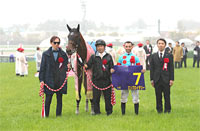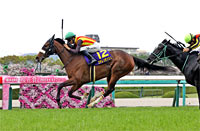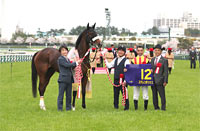Oka Sho (Japanese 1000 Guineas) (G1) - Data Analysis
Spring classic races to kick off at Hanshin Racecourse
The Oka Sho (Japanese 1000 Guineas) is the first leg of the Triple Crown for fillies. Among the last six winners, three went on to also dominate the second leg [Yushun Himba (Japanese Oaks)] and the third leg (Shuka Sho) to claim the title of Japanese Fillies Triple Crown winner: Almond Eye in 2018, Daring Tact in 2020, and Liberty Island in 2023. Other famous names that have triumphed in the race include Gran Alegria (2019), who racked up six G1 wins in races with a distance of 1,600m or less. In other words, the race has been won by an impressive lineup of top performers in recent years. Let’s now analyze some features shared by successful runners in this race based on results over the last 10 years.
Consecutive wins by runners coming from a non-trial race in recent years
Looking at performances by runners over the last 10 years in terms of their previous race, the first thing we notice is that runners coming straight from a G1 race for two-year-olds enjoyed high success ratios. Among the 11 runners coming from the Hanshin Juvenile Fillies or the Asahi Hai Futurity Stakes, which together accounted for less than 10% of the total runners, Gran Alegria triumphed in 2019, Sodashi in 2021, and Liberty Island in 2023. The six Oka Sho races since 2018 (when Almond Eye was victorious) have been consistently won by runners coming from a non-trial race, including the three aforementioned winners. Runners coming from the Tulip Sho delivered the largest number of Top 3 finishers over the period, with five runners-up but no winners. We should keep these trends in mind when placing Exacta or Trifecta bets. [Table 1]
[Table 1] Performance by previous race (last 10 years)
| Previous race |
Performance
[1st-2nd-3rd-4th or lower] |
Win ratio |
Top 2 ratio |
Top 3 ratio |
| Hanshin Juvenile Fillies |
2-2-0-5 |
22.2% |
44.4% |
44.4% |
| Asahi Hai Futurity Stakes |
1-0-0-1 |
50.0% |
50.0% |
50.0% |
| Tulip Sho |
3-8-6-30 |
6.4% |
23.4% |
36.2% |
| Hochi Hai Fillies’ Revue |
1-0-2-43 |
2.2% |
2.2% |
6.5% |
| Daily Hai Queen Cup |
1-0-1-18 |
5.0% |
5.0% |
10.0% |
| Nikkan Sports Sho
Shinzan Kinen |
1-0-0-2 |
33.3% |
33.3% |
33.3% |
| Elfin Stakes |
1-0-0-3 |
25.0% |
25.0% |
25.0% |
| Race other than the above |
0-0-1-46 |
0% |
0% |
2.1% |
Among poorly favored runners, watch those coming from trial races
Gran Alegria, Sodashi, and Liberty Island all came straight from a G1 race and lived up to expectations by securing the win backed by high favoritism. Top 2 favorites who had previously contested a G1 race delivered performance of [3-2-0-0], proving to be even more reliable. Meanwhile, when turning our attention to poorly favored runners, we find that 10 runners backed as 6th to 9th favorite also finished within the Top 3. In this group, runners coming from the Tulip Sho or the Hochi Hai Fillies’ Revue achieved strong performance of [1-3-4-12] with a Top 3 ratio of 40.0%. We should look for dark horses in this group as runners backed as 10th favorite or lower have not achieved a Top 3 finish. [Table 2]
[Table 2] Performance by favoritism (last 10 years)
| Favoritism |
Performance
[1st-2nd-3rd-4th or lower] |
Win ratio |
Top 2 ratio |
Top 3 ratio |
| 1st favorite |
2-3-1-4 |
20.0% |
50.0% |
60.0% |
| 2nd favorite |
4-2-0-4 |
40.0% |
60.0% |
60.0% |
| 3rd favorite |
1-2-2-5 |
10.0% |
30.0% |
50.0% |
| 4th favorite |
0-0-0-10 |
0% |
0% |
0% |
| 5th favorite |
1-0-2-7 |
10.0% |
10.0% |
30.0% |
| 6th-9th favorite |
2-3-5-30 |
5.0% |
12.5% |
25.0% |
| 10th favorite or lower |
0-0-0-88 |
0% |
0% |
0% |
Also watch favoritism until the previous race
Looking at performances by runners in terms of favoritism in their previous race, we find that all winners over the last 10 years had been backed as 3rd favorite or higher in their previous race. In particular, runners that had contested a JRA graded race last time out as race favorites achieved performance of [8-3-4-16] with a high Win ratio of 25.8%. [Table 3]
[Table 3] Performance by favoritism in previous race (last 10 years)
Favoritism in
previous race |
Performance
[1st-2nd-3rd-4th or lower] |
Win ratio |
Top 2 ratio |
Top 3 ratio |
| 3rd favorite or higher |
10-7-7-76 |
10.0% |
17.0% |
24.0% |
| 4th favorite or lower |
0-3-3-72 |
0% |
3.8% |
7.7% |
In addition, all winners except 2015 winner Let’s Go Donki had been backed as 3rd favorite or higher, not only last time out but in all their previous races. Runners who had not been backed as 4th favorite or lower until entering the Oka Sho achieved a high Top 3 ratio of 35.8%. In this group, those that were also backed as 3rd favorite or higher in the Oka Sho turned in performance of [7-4-3-8], producing an even higher Top 3 ratio of 63.6%. [Table 4]
[Table 4] Performance by experience of being backed as 4th favorite or lower (last 10 years)
| Experience |
Performance
[1st-2nd-3rd-4th or lower] |
Win ratio |
Top 2 ratio |
Top 3 ratio |
| Yes |
1-5-5-114 |
0.8% |
4.8% |
8.8% |
| No |
9-5-5-34 |
17.0% |
26.4% |
35.8% |
Runners without a proven track record in same-distance races inevitably struggle
Of the 30 Top 3 finishers over the last 10 years, 27 had experience of finishing within the Top 3 of a graded race or winning an open-class race contested on a 1,600m turf track. Runners without such experience achieved only third place as their highest finish with a Top 3 ratio of 4.1%, suggesting a stronger likelihood they will struggle. Among runners coming with this kind of track record, we should especially focus our attention on those that have experience of finishing within the Top 3 of a 1,600m graded turf race held at Hanshin Racecourse, resembling the Oka Sho. Runners in this group delivered performance of [7-9-5-25] with a Top 3 ratio of 45.7%. [Table 5]
[Table 5] Performance by experience of finishing within the Top 3 of a graded race or winning an open-class race contested on a 1,600m turf track (last 10 years)
| Experience |
Performance
[1st-2nd-3rd-4th or lower] |
Win ratio |
Top 2 ratio |
Top 3 ratio |
| Yes |
10-10-7-77 |
9.6% |
19.2% |
26.0% |
| No |
0-0-3-71 |
0% |
0% |
4.1% |
Seek out the winner!
Career starts and consistent performance also key factors
As is evident from Table 1, our main focus should be on runners that have also contested a 1,600m turf race in their previous race. Runners coming from races other than a 1,600m turf race produced only one winner: Reine Minoru in 2017. In addition, among the last 10 winners, Reine Minoru was also the only runner to enter the race with six or more career starts and experience of having been beaten to 4th or lower. In other words, we can conclude that “runners with five or fewer career starts, without experience of having been beaten to 4th or lower, and coming from a 1,600m turf race” are the most reliable win contenders. [Table 6]
[Table 6] Winners’ distance of previous race, total career starts, and experience of having been beaten to 4th or lower (last 10 years)
| Year |
Winner |
Distance in
previous race |
Total
career starts |
Experience of having been
beaten to 4th or lower |
| 2014 |
Harp Star |
1,600m turf race |
4 |
No |
| 2015 |
Let’s Go Donki |
1,600m turf race |
5 |
No |
| 2016 |
Jeweler |
1,600m turf race |
3 |
No |
| 2017 |
Reine Minoru |
1,400m turf race |
6 |
Yes |
| 2018 |
Almond Eye |
1,600m turf race |
3 |
No |
| 2019 |
Gran Alegria |
1,600m turf race |
3 |
No |
| 2020 |
Daring Tact |
1,600m turf race |
2 |
No |
| 2021 |
Sodashi |
1,600m turf race |
4 |
No |
| 2022 |
Stars on Earth |
1,600m turf race |
5 |
No |
| 2023 |
Liberty Island |
1,600m turf race |
3 |
No |
(Maya Takanami)
|

- Preview
- Barrier draw
- Past performances of runners

- News
- Race result
- Video
- 2025 English

- 2024 English

- 2023 English

- 2022 English

- 2021 English

- 2020 English

- 2019 English

- 2018 English

- 2017 English

- 2016 English

- 2015 English

- 2014 English

- 2013 English

- Photo Gallery
2025 Winner: Embroidery


2024 Winner: Stellenbosch


|




















